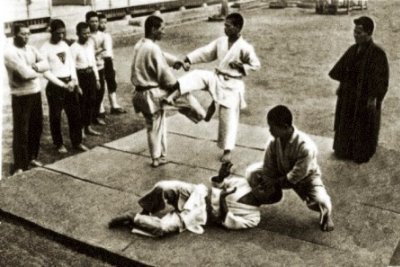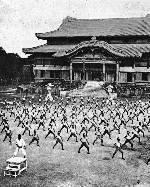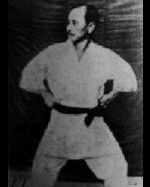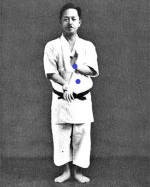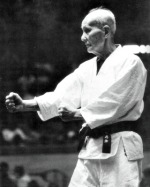The Real Mr Miyagi – Founder of Goju-Ryu
Talk the Talk
Goju Ryu literally means Hard (Go) Soft (Ju) Style (Ryu) and is based on the Chinese principle of two opposing forces that govern everything in the universe, Yin and Yang.
Walk the Walk
Chojun Miyagi emphasised the importance of correct breathing while practising karate and created the breathing exercise known as Ibuki, which combines external and
internal breathing techniques.
The two types of Ibuki are, Yo Ibuki, which is employed as a training method and is a strong hissing sound which aids in dynamic tension
training, and In Ibuki, which is used in combat or while training and is nasal in nature.
The combination of these breathing techniques promotes the rejuvenation of energy and
ensures the body is exercised both internally and externally.
Karate Quote
"People often misunderstand karate. When they see someone breaking five wooden boards or a few pieces of roof tile with his or her fist, they think it is a main part of
karate.
Of course, it is not a main part of karate but a trivial part of karate.
Like other fighting arts, the truth of karate or Tao of karate can be understood and mastered at the ultimate goal, which is beyond teachings and impossible to describe by words."
Of course, it is not a main part of karate but a trivial part of karate.
Like other fighting arts, the truth of karate or Tao of karate can be understood and mastered at the ultimate goal, which is beyond teachings and impossible to describe by words."
~ Chojun Miyagi ~
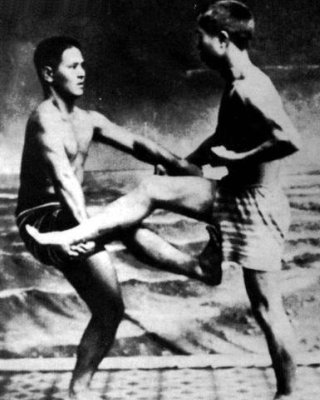
Everybody of a certain age remembers the character Mr Miyagi from the hit 1980s movie The Karate Kid. However, what many people do not realise is the wise old
karate teacher was in fact based on a real-life master from Okinawa who founded one of the most successful forms of the martial art, Goju-Ryu karate.
Blending Kung Fu with Okinawan Karate
Sensei Chojun Miyagi (1888 – 1953) began his training at an early age and when he turned 14, he was sent to study under the great
master Kanryo Higaonna. While working in China, Higaonna had the opportunity to study kung fu and blended his new knowledge with the style he himself had been taught in his
hometown of Naha (later this style would become known as Naha-te).
Though training was extremely hard, the young Miyagi excelled and through great determination and a large
amount of raw natural talent, was able to progress in the art very quickly. After his teacher died in 1915, Miyagi also went to China and though he did not intend to
learn Chinese martial arts, what he saw there piqued his interest so he began studying.
He attended the Pakua Chan School which emphasised the soft aspects of the martial arts and was particularly interested in the internal systems and breathing techniques they taught there that promoted inner peace and harmony of the mind, body and spirit. He also studied at the School of Shaolin Chuan which had a more external focus on training adding to the hard techniques he had learned from Okinawan martial arts.
The Development of Goju-Ryu Karate
The hard aspect of Goju-Ryu incorporates open-handed blocking with a circular motion along with strong punching and striking techniques. The legs are also utilised effectively and while high kicks are popular today, Miyagi taught that kicks should be kept low in order to maximise their effectiveness while minimising the risk (as high kicks are less likely to hit the target and may result in a loss of balance). Goju-Ryu karate also incorporates the use of many other types of techniques including sweeps, throws, joint locks and grappling.
In the early twentieth century, Okinawan karate masters were in great demand in Japan which appealed to Miyagi, so he went and began teaching classes at Kyoto University. However, after a while he became homesick and returned to Okinawa, taking some of his best students with him. One of Sensei Chonju Miyagi’s students who did not follow him back to his homeland however was Gogen Yamaguchi, who instead stayed in Japan and became a very successful teacher there. Known as The Cat because of his agility, cunning and speed when fighting, he further developed the style by organizing it into the system that is used all over the world today, forming the association known as Goju Kai.
Chonju Miyagi spent the rest of his life developing and teaching Goju-Ryu karate while Yamaguchi did likewise in Japan. On his deathbed, the founder of the style named Yamaguchi as his successor, before passing away on 8 October 1953 at the age of 65. Today, his legacy lives on and he is considered a legend of martial arts history. His name will always be remembered through the style he created which despite some modifications down the years, is still easily recognisable as the karate of the real Mr Miyagi.
Written by Andrew Griffiths – Last updated 22/10/2023. If you like
what you see, consider following the History of Fighting on social media.
Further Reading:
About Goju-Ryu. [Internet]. 2013. Texas A&M University. Available from: http://gojuryu.tamu.edu/node/4 [Accessed May 30, 2013].Ceberano, T. [Internet]. 2012. History of Goju Karate. Purdue University. Available from http://web.ics.purdue.edu/~karate/goju [Accessed May 30, 2013].
Chojun Miyagi. [Internet]. 2013. Academy of Traditional Fighting Arts. Available from: http://www.wuweidao.com/history_goju-ryu.htm [Accessed May 30, 2013].
Miyagi, C. 1936. Historical Outline of Karate-Do, Martial Arts of Ryukyu. Available from: http://seinenkai.com/articles/sanzinsoo/outline.html [Accessed May 30, 2013].
Grandmaster Chojun Miyagi - Founder of Okinawan Goju-Ryu Karate-do. [Internet]. 2010. Northwest Goju Rye Karate. Available from: http://www.northwestgoju.org/chojun-miyagi.shtml [Accessed May 30, 2013].
History of Goju Ryu Karate. [Internet]. 2013. North Carolina State University. Available from: http://www4.ncsu.edu/~lwcassid/karate/history/ [Accessed May 30, 2013].
Martial Arts History. [Internet]. 2013. Sama Organisation. Available from: http://samaorganisation.co.uk/history.asp [Accessed May 30, 2013].
More Karate History
Karate History Home
The history of karate begins in Okinawa, where martial arts were influenced by both kung fu from China, and the Japanese samurai. After weapons were banned on the island, unarmed combat techniques were developed into a style of fighting recognisable as traditional karate, which was further developed after being taken to Japan in the early twentieth century by Gichin Funakoshi.
The history of karate begins in Okinawa, where martial arts were influenced by both kung fu from China, and the Japanese samurai. After weapons were banned on the island, unarmed combat techniques were developed into a style of fighting recognisable as traditional karate, which was further developed after being taken to Japan in the early twentieth century by Gichin Funakoshi.
The History of Okinawan Karate
A look at the history of Okinawan karate and how it developed from the seventeenth century. Okinawan martial arts had influences from both the Japanese samurai and Chinese kung fu, as well as techniques unique to the island itself which over the years blended and evolved into the traditional karate styles that are practiced all over the world today.
A look at the history of Okinawan karate and how it developed from the seventeenth century. Okinawan martial arts had influences from both the Japanese samurai and Chinese kung fu, as well as techniques unique to the island itself which over the years blended and evolved into the traditional karate styles that are practiced all over the world today.
The Life and Legends of Anko Itosu
Anko Itosu was a legendary Okinawan martial artist and a pioneer in the development of karate history. He popularised many aspects of the fighting system through his Shuri-te style and helped increase the number of people who were permitted to learn it by bringing karate training out of secrecy, and even gained permission to teach it in Okinawan schools.
Anko Itosu was a legendary Okinawan martial artist and a pioneer in the development of karate history. He popularised many aspects of the fighting system through his Shuri-te style and helped increase the number of people who were permitted to learn it by bringing karate training out of secrecy, and even gained permission to teach it in Okinawan schools.
Gichin Funakoshi - Father of
Modern Day Karate
Gichin Funakoshi was born in Okinawa in 1868 and is known as the father of modern-day karate due to the innovations he made to Okinawan martial arts when he took it to Japan and popularised it with the people there. Not only did he found Shotokan karate, but he was also instrumental in spreading karate across the world.
Gichin Funakoshi was born in Okinawa in 1868 and is known as the father of modern-day karate due to the innovations he made to Okinawan martial arts when he took it to Japan and popularised it with the people there. Not only did he found Shotokan karate, but he was also instrumental in spreading karate across the world.
The History of the Shotokan Kata – Part One
A look at the history of the more basic Shotokan kata, including their origins, development, interesting facts and scholastic debate. This list of kata histories includes, Kihon kata, the Heian kata, the Tekki group, Bassai Dai and Sho, Empi, Hangetsu, Kanku Sho and Dai, Jion, Ji’in and Jitte and includes video links to the relevant kata.
A look at the history of the more basic Shotokan kata, including their origins, development, interesting facts and scholastic debate. This list of kata histories includes, Kihon kata, the Heian kata, the Tekki group, Bassai Dai and Sho, Empi, Hangetsu, Kanku Sho and Dai, Jion, Ji’in and Jitte and includes video links to the relevant kata.
The History of the Shotokan Kata – Part Two
A look at the history of the more advanced Shotokan kata, including their origins, development, interesting facts and debated issues. This list of karate kata histories includes, Wankan, Gankaku, Meikyo, Chinte, Gojushiho Sho and Dai, Sochin, Nijushiho and Unsu, and includes video links to the relevant kata.
A look at the history of the more advanced Shotokan kata, including their origins, development, interesting facts and debated issues. This list of karate kata histories includes, Wankan, Gankaku, Meikyo, Chinte, Gojushiho Sho and Dai, Sochin, Nijushiho and Unsu, and includes video links to the relevant kata.
Kenwa Mabuni – Founder of Shito-Ryu Karate
Kenwa Mabuni started life as a sickly child but transformed himself into a strong warrior through the practice and dedication to the martial arts. Through his studies with
great karate masters such as Anko Itosu and Kanryo Higaonna, along with the kung fu master Woo Yin Gue, he was able to combine what he had learned and develop one of the four
major styles of traditional karate, Shito-Ryu.
Hironori Otsuka – Founder of Wado-Ryu Karate
Hironori Otsuka was a renowned master of jujitsu by the age of 28 before becoming a karate student under Gichin Funakoshi. He excelled and quickly rose through the ranks to become an assistant instructor, helping to develop training techniques in Shotokan karate. Later, Master Otsuka would brake away and form Wado-Ryu, one of the main four styles of traditional karate.
Hironori Otsuka was a renowned master of jujitsu by the age of 28 before becoming a karate student under Gichin Funakoshi. He excelled and quickly rose through the ranks to become an assistant instructor, helping to develop training techniques in Shotokan karate. Later, Master Otsuka would brake away and form Wado-Ryu, one of the main four styles of traditional karate.
Mas Oyama – Founder of Kyokushin Karate
Mas Oyama, founder of Kyokushin karate was one of the best karate masters of all time. He developed his body, mind and techniques through rigorous training and fought and won hundreds of full contact battles against fighters from many different martial arts styles. To test his skills further, he also went head to head with 52 bulls and was victorious in all, whether against man or beast.
Mas Oyama, founder of Kyokushin karate was one of the best karate masters of all time. He developed his body, mind and techniques through rigorous training and fought and won hundreds of full contact battles against fighters from many different martial arts styles. To test his skills further, he also went head to head with 52 bulls and was victorious in all, whether against man or beast.
The images on this site are believed to be in the public domain, however, if any mistakes have been made and your copyright or intellectual rights have been breeched, please contact andrew@articlesonhistory.com.

